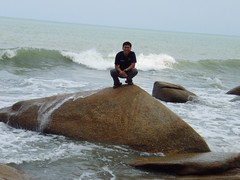
Mera Peak Summit Mound
Source: blog.wuokko.org
Mera Peak at 6,476 metres (21,247 ft) it is classified as a trekking peak. It contains three main summits: Mera North, 6,476 metres (21,247 ft); Mera Central, 6,461 metres (21,198 ft); and Mera South, 6,065 metres (19,898 ft), as well as a smaller "trekking summit", visible as a distinct summit from the south but not marked on most maps of the region.
The view from the summit is spectacular. On a clear day, five of the six highest mountains on Earth. Cho Oyu (8201m), Lhotse (8516m), Everest (8848m) and Makalu (8463m) are all very close by, and when it’s clear you may just be able to see Kangchenjunga (8586m) on the Indian border far away to the east. Only K2 (8611m) in distant Pakistan is beyond your vision.

View from the summit
Source: Summitpost
From Lukla, it is possible to approach Mera in a number of different ways. The quickest involves leaving the airport and joining the trail that heads east, stopping at Chutang or a neighbouring settlement, before crossing the Zatrwa La (4610m) and descending to Thuli Kharka and on to the Hinku Valley (3 days or less). We elected not to go over the Zatrawa La early on in the trek.
A second, much slower approach, is to trek south from Lukla and spent several days passing through Poyan, Pangkongma, Nashing Dingma, Chalem Kharka and Chunbu Kharka before eventually descending into the Hinku Valley at Tashing Ongma. We decided to do this remote and beautiful route up the Hinku valley to really see the country, passing through rhododendron and bamboo forest, up to grassy moorland and along high mountain trails. This provides a fantastic trek which for many will be as memorable as the climb itself.

Map of the route
This will not only give us a better taste of this part of Nepal, its countryside and its people, but it also provides a better acclimatisation programme. By slowly increasing your sleeping altitude from 2800m to 4200m it gives you an excellent chance to acclimatise and minimise your risk of developing Acute Mountain Sickness (AMS) and life threatening conditions such as High Altitude Pulmonary Edema (HAPE) and High Altitude Cerebral Edema (HACE).





No comments:
Post a Comment